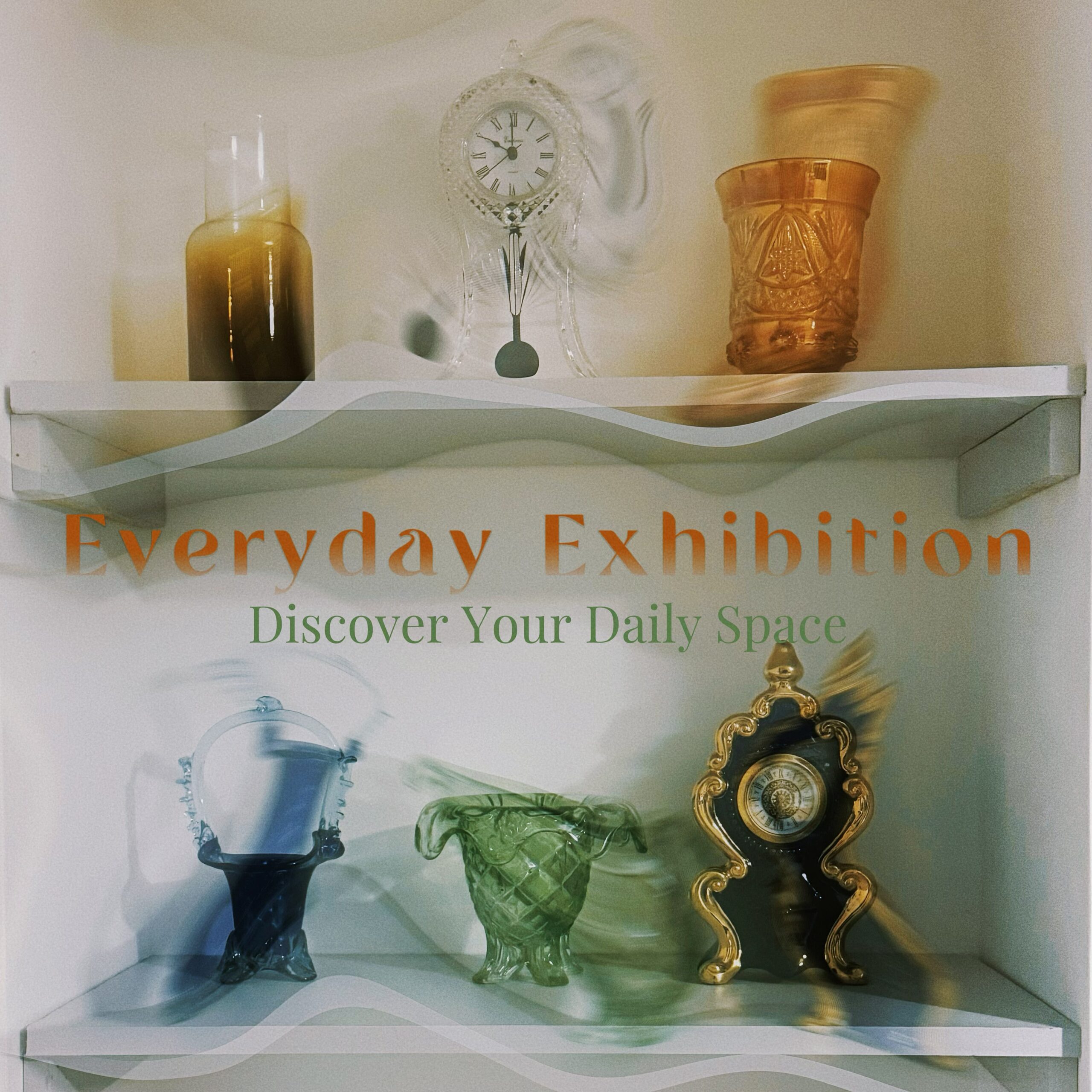Everyday Exhibition: Discover Your Daily Space

Summary
This toolkit guides participants through a 20-minute “micro-curation” practice, inviting them to observe, rearrange, and reflect on a small corner of their daily living environment. By documenting the original state, re-arranging the space, and giving it an exhibition title, participants become aware that exhibitions do not belong only to museums,they are continuously unfolding in everyone’s lived spaces. Everyday environments function as unconscious forms of self-presentation and personal narrative. This practice aims to help learners reconsider the relationships between objects, space, and the self, and to discover aesthetics, storytelling, and agency within everyday life.
“We perform ourselves in everyday life.”——Erving Goffman – The Presentation of Self in Everyday Life
Introduction (1 minutes)
Everyday Exhibition is an online, self-paced micro-curation toolkit that invites you to slow down and rediscover the aesthetics hidden in your daily life.
It does not require a specific space, a tidy home, or any special tools.
What it offers is 20 quiet minutes that belong entirely to you to observe, rearrange, imagine or simply recall a corner of everyday life that shapes who you are.
We often assume that exhibitions happen only in museums.
But in reality, every desk, bedside table, kitchen counter, bag interior, or shoe rack you use is already a subtle exhibition.
These small spaces reveal your habits, emotions, rhythms, and ways of being often without your awareness.
Through this toolkit’s micro-curation process, you will:
- notice objects you have long overlooked
- rewrite the meaning of a familiar space
- reflect on yourself through the arrangement of daily things
- or simply pause and inhabit a moment of quiet attention
You may realize that everyday life is already an exhibition, and you are both the curator and the exhibited subject.

Three Participation Pathways(30 seconds)
You may freely choose the method that best fits your situation.
Path A — Real Space
Take a before photo on the spot → rearrange your chosen corner → take an after photo.
Path B — From Your Gallery
Choose an everyday-corner photo from your phone gallery → curate or re-imagine it using text or simple annotations → write an exhibition label.
Path C — Pure Imagination
No images needed → imagine one of your “everyday corners” → describe the before / after and your discoveries using text only.
📌This toolkit does not restrict where you are : home, dorm, office, classroom, anything works.
Materials Needed (30 seconds)
You only need:
-
A phone or camera (to take photos)
-
A small corner of your living space
-
Paper and pen (optional, for reflection)
Example Walkthrough (2 minutes)
Personal Example:“Tomorrow, Briefly Arranged”

“Before” photo

“After” photo
My Exhibition Label:
Empty hangers, undecided clothing, and accessories already hung up give “Tomorrow” a semi-complete, open-ended appearance: it is both a plan and a possibility.

“It’s simple, right?
Just a small corner, a quiet moment, and a bit of attention.
Now it’s your turn,let’s walk through the steps together.”
Steps
Step 1: Observe (3–5 minutes)
Depending on your chosen pathway (A / B / C), begin by either:
📸observing the corner in front of you,
📱examining the photo you selected from your gallery,
📝or constructing an imagined everyday corner in your mind.
To spark your thinking, here are optional prompts you may consider.
These are inspirations,not rules, and you do not need to answer all of them:
-
What is the first thing that draws your attention?
-
If this were the beginning of a story, where would it start?
-
What is the atmosphere or mood of this corner?
-
Which objects seem to be “speaking” about you?
-
If this were part of an exhibition, what might its title be?
Step 2: Curate (Rearrange) (6–8 minutes)
Continue according to the pathway you selected:
Path A · Real Space
Gently move objects, shift angles, tidy, stack, or create areas of empty space.
It does not need to become beautiful—any small change counts.
Path B · From Your Gallery
Work directly on your chosen photo. You may:
-
add notes or marks
-
draw frames or lines
-
highlight relationships
-
add text
-
annotate what you wish to change
Path C · Pure Text Curation
Write two short sections:
-
“Before: What did this corner originally look like?”
-
“After: How would I rearrange it, and why?”
You may:
-
Adjust the placement of objects
-
Add a new object
-
Remove something unnecessary
-
Change the lighting or camera angle
Give your mini-exhibition a title.
Examples:
-
The Illusion of Control
-
Emotional Storage System
-
Preparing for Tomorrow
-
Organized Chaos
- Stillness
Ask yourself:
-
What is this exhibition showing?
-
What story is this space telling?
- If this were a museum display, what would the label say?
Step 3: Reflect (3–5 minutes)
✍️Write a short reflection ,just one or two sentences are enough.
You may write it in your notebook, on your phone, or directly in the toolkit’s comment area.
Write at least one sentence:
-
“If my life were an exhibition, its theme would be ______.”
-
“The objects here reflect my habit of ______.”
-
“This corner reveals not objects, but ______.”
- “What I curate every day is survival.”
Closing Thought (30 seconds)
Exhibitions don’t only exist in museums.
Every space you enter and every object you interact with quietly tells your story.
Everyday life is an exhibition,you are both the curator and the exhibited subject.


